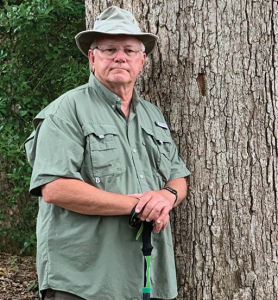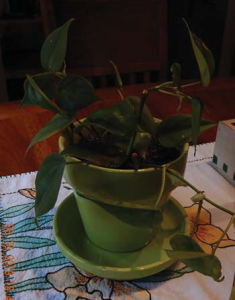By: Kim Flottum
It’s been a quiet month here in the Spieth Road Beeyard. The weather settled, kind of, and things started to dry out a bit after the monsoons of June and early July. Hot was the norm, but with all the moisture in the ground the honey flows pretty much didn’t stop and from what I hear beekeepers, and their bees, did pretty good. August harvests were as good and for a lot of us better than normal in this part of Ohio. The best part is that as I write this the goldenrod bloom is just starting, maybe just a tad early, but right about on time. This will be a good test of the rain-rule for that Fall bloomer – No Rain In July, No Honey In September. That’s held pretty steady since we worked on it with the botany folks decades ago when I was at the University in Madison. Back then we had a good goldenrod flow some years and some years none, no matter the August or September weather. The botany folks looked at nectary formation just as flower buds were forming – in July – and found, they said, that if there was water stress in July, there’d be no, or diminished, nectaries formed to produce honey in September. I’m not a botanist, but it makes sense, and that’s been pretty much dead on all these years here in Ohio. So, we should have a good goldenrod crop. Still, everybody has their fingers crossed.
•
Did I mention we had supper with Jim and Vallie Tew just the other night? They live about 30 miles south of us in Wooster and we met at a restaurant about half way between. They brought us up to date on that new development that’s going to go in right next to their beeyard way sooner than they want.
We were down there about three weeks before and did a KIM&JIM Webinar to take a look at all this craziness (you can see that program on our web page if you want). We brought Johnny, the tech guy from our office who makes these webinars work for us, so he could monitor everything from right there rather than do a remote from back at the office. He’s a hand’s on tech guy and in fact he brought his drone that has a video camera to give us, and you, a bird’s eye view of the field that will be the grounds for the development, plus the forests and the few houses that are on the edge of what was just last year a corn field.
This is going to be a mess and a half for all those Wooster folks who have been living the quite life on a dead-end street next to a corn field all these years. Suddenly they’ll have school buses, fire truck sirens, garbage trucks, gangs of adolescents, city snow plows and salt trucks, fertilized and poisoned lawns, morning and evening rush hours, police patrols, rain runoff and all the rest of our urban ills right next door. All told, there’s 20 some acres going under the grader and houses are going to go on quarter acre lots. That figures to 70 some new houses, garages and driveways, yards and families and dogs and cats all sprouting up like mushrooms after a rain storm. Plus, yes plus, there will be a two or three mile asphalt grid of streets serving all these new folks, and twice that in concrete sidewalks laid out. All this snuggled right up next to Jim’s beeyard.
They’ve had the Mayor and other city administrators – police, fire, garbage, ambulance, school – out to look, but you know the story – progress, growth, jobs, new taxes . . . Nope, it’s welcome to urban America folks, and 20 some acres of chaos right next door. If you recall that report we did last month we lose about three acres of farmland a minute and in the time it took you to read this we lost about 10 acres. But don’t fret, there will be at least 10 more gone by the time you get to the bottom of this, and Wooster, you got ‘em all.
•
For more reasons than I can get on this page, for the last about five years the third bedroom in our house hasn’t been the office. It used to be, then wasn’t, and now it is again. The desk butts up to two second story windows so if I look straight out, I’m looking at the trunk of a really, really tall sycamore tree about 30 feet away. It throws out its first branches about right even with the top of my desk so it doesn’t block much of what I can see. To the left of that tree is the neighbor’s backyard, to the right further away a couple of not quite as tall trees, and just past them the neighbor’s front yard, and then the road that goes by our house. Front of our house to my right, backyard to the left. I’m facing east. Right next to this side of the house just to the right of my windows is one of our beehives, and, from where I now sit, I can see bees raising up, flying way, way up over the trees in front of them. Not, mind you, going around all these trees on either side, which, at most, would add about 40 feet to their trip. Rather, they fly up, oh, at least two, maybe three stories, then back down to about 10 feet high, and off to the forage they know is out there. Why up, and not around?
It’s Been a Quiet Month
I know bees do the beeline thing when heading somewhere, at least most of the time. Up and over houses, trees and the like heading out, or back. There’s been some work on how much water they will fly over to get to where they want to be but water isn’t the issue here. And, if you’re at all familiar with the dances of bees, they don’t do a ‘go left around the trees just out front, then straighten out and head due south till you get to the field that smells like I do right now’ waltz ever. It’s just ‘go south young lady, go south’.
What caught my eye from my new perspective was in the afternoon, when the sun was in the west sky, and not yet behind the house, sun light would shine off the wings of those rising bees, heading straight up over those trees. Once you noticed that phenomena it was all you could see. Streaks of flashing wings rising from right below my window out of sight above my window, heading up, up and away.
So I ask again, why straight up and not around? It seems like a lot of unnecessary work, but then, what do I know? It does save a lot of time and energy when giving directions. I wonder how’d they do a waggle dance with a quirky left around the trees then back to that straight line I just showed you?
•
By the time you get this the Apimondia conference in Montreal will be history. We plan to be there and will be doing some interviews, visiting the vendor tables, reading all the posters that will be shown and catching some of the talks, workshops and symposiums. Back in August Jeff and I did a Beekeeping-today podcast with Steve Pernell, the scientific program chair who shared a lot of both what goes into planning one of these events, and what has been planned other than the scientific portion of the week. For this conference he has the same job that Mark Winston did back in 1999 when Apimondia was in Vancouver, British Columbia. We were at that one and had a booth and won a Gold Medal for our magazine, plus gave a talk about information transfer in the beekeeping industry.
But a whole lot has changed in those 20 years. Especially information transfer. The internet and social media certainly lead the way. Podcasts, webinars, email, web pages, smart phones, online shopping and classes and entertainment and everything and anything you want to do or see or hear or read or learn or people you want to talk to or read about and instant news and weather from anywhere in the world any time of day, any day of the week.
So, we will try to take advantage of some of that this time. In the past few years when we’ve been at conferences – EAS or ABF or AHPA mostly – doing exactly that. We’ve done some FaceBook live events at several of these conferences. We visit vendors who tell us about what they have that’s new, different, better or whatever, or we’ll grab one of the speakers and do a quick interview, and we broadcast it live for anybody who wants to watch. All you need to do this is a smart phone, somebody to hold it, and somebody that knows how to use Facebook. I’m not that person, but Kathy is and we are getting pretty good at this.
Because these are done live it can get a bit dicey sometimes. We were talking live to a vendor at one of the meetings with several hundred people watching (your phone will tell you exactly how many the whole time you’re recording), and a customer came up and started asking questions. She wasn’t being rude but didn’t realize what we were doing and just kept talking. Fortunately, the Vendor didn’t get flustered, and the customer didn’t do anything awkward, so it worked out. I was on camera so I made a comment something like well, we’ll get back to these folks in a bit when they have a few moments free time, and we moved on, kind of like it was supposed to happen. Thinking fast pays off when you’re on live. But not only are these events live, they are recorded on our FaceBook page so if you missed the live event, you can watch it later, when you have time. And, the vendor can capture the recording and send it to all of their FaceBook followers, so it’s essentially free advertising for them. We get a lot of cooperation because of that.
We give everybody a heads up the day before (including you on Facebook) so they know about when we’ll be there so they are there, and they can have whatever it is they want to show ready and right at hand. Most of them actually rehearse a bit so they don’t get flustered. It makes them look good, shows off their product, and folks tuning in don’t waste their time watching people stutter or search for words or just not do it well.
I’m assuming we actually did some of these while we were there, that our equipment worked, and, and this is the biggest problem we have, we could get a phone signal in the building. If we lose that we are out of business. Or, we have to drag a vendor or speaker to some place that does get a signal. That’s a pain and we don’t do much if that’s the case. So, if you didn’t see anything, or, you go looking and can’t find anything on FaceBook you’ll know why.
However, I will be recording a bunch of interviews of these same folks to use on our podcast, and you don’t need a signal for that. Just my phone and a mic. And we’ll have two phones so one is a backup. And, when you finish you don’t need to store the recording, you simply put the file on the Dropbox app on the phone and send it to a couple of people so you have it twice and then delete the whole thing from your phone. So check out the BeekeepingTodayPodcast. com web page for those, too. And when I get back I’ll tell you all about the other stuff at the Apimondia Conference. Stay tuned.









